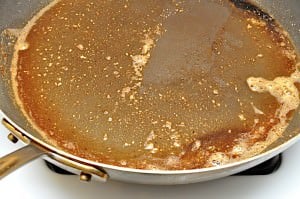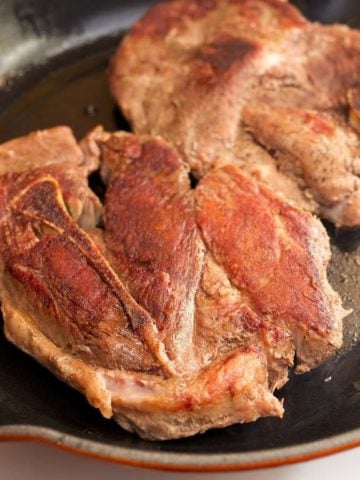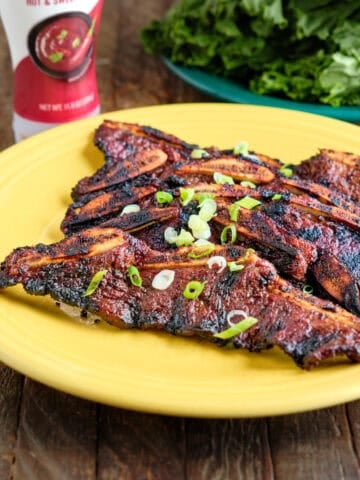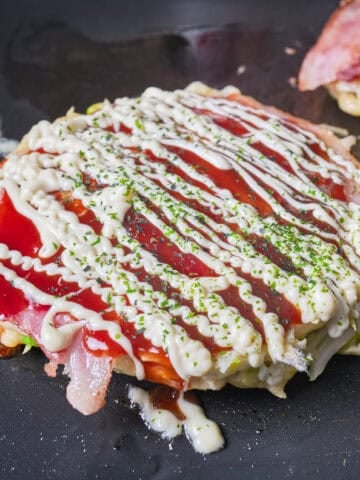Tilapia is an example of a good farmed fish. They are omnivorous, and thrive on a vegetarian diet; don't mind being packed tight in growing pens; do well in any water conditions, as long as it is warm; and grow quickly to market size. And, in the United States, tilapia is farmed in closed inland systems to protect against escapees and pollution. Because of these traits, tilapia is now the third most common farmed fish, behind carp and salmon.
Tilapia's big advantage is being omnivorous, which helps their feed conversion ratio. They take in less protein than they produce; tilapia farming is a net gain in protein. The counter-example is salmon. Salmon are carnivorous, and farmed salmon requires at least three times as much protein as it produces.
Tilapia is a mild tasting, white fleshed, flaky fish, perfect for a weeknight fish dinner. I like them steamed and poached, but my favorite way to cook tilapia is sauteing. I coat this mild fish in a cornmeal crust to give it some crunch, and make sure to serve it with a flavorful sauce. In this recipe, I went with a simple browned butter sauce and a squeeze of lemon. The result is a fish dinner that even my kids will eat, that comes together in no time at all.
I try to find farmed tilapia from the US, as recommended by Seafood Watch. If you want to try really fresh tilapia, seek out your local Asian market with a fish counter. I can almost guarantee they will have a tank of live tilapia, and will kill it for you on the spot. Don't worry if the water in the tank looks dirty or cloudy, or if the fish are packed in there - tilapia thrive under those conditions.
*As Tony Bourdain said, the Asian definition of fresh fish is much different from ours. Theirs is: was the fish alive when it entered the kitchen?
Recipe: Tilapia with Brown Butter and Lemon Sauce
Inspired by: Paul Greenberg Four Fish: The Future of the Last Wild Food
Ingredients:
- 2 lbs tilapia ( 6 to 8 tilapia filets, depending on thickness)
- salt and pepper
- 1 cup cornmeal
- 2 tablespoon vegetable oil
- 3 tablespoon butter
- juice of 1 lemon
Directions:
1. Prepare the tilapia: Sprinkle the tilapia evenly with salt and pepper. Put the cornmeal in a shallow pan. Just before cooking the tilapia, coat it with a thin layer of cornmeal, shaking to remove any excess.
2. Saute the tilapia: Heat 1 tablespoon of vegetable oil in a 12" nonstick fry pan over medium-high heat until it is shimmering. Cook the tilapia in two batches. Put half of the tilapia in the pan. Shake the pan to get some oil under the fish, then cook undisturbed for four minutes, or until well browned. Flip the tilapia and cook for another 2 to 4 minutes on the other side. The fish should flake when pressed. Remove the tilapia to a platter, and add the remaining 1 tablespoon of oil to the pan. Let the oil heat for a minute, then add the second batch of tilapia to the pan. Cook the same way as the first batch - 3 minutes, flip, then 2-4 minutes or until browned and flaking. Move the second batch to the platter, and drizzle the tilapia with the lemon juice.
3. Make the browned butter sauce: Reduce the heat under the pan to medium, then add the 3 tablespoons of butter. Cook, stirring often, until the butter is just turning brown, about 3 minutes. Pour the butter over the tilapia, and serve.
Variations:
Toasted Almonds: For some extra crunch, add toasted almonds to the pan with the butter when making the sauce.
Garlic butter: While making the browned butter sauce, add 1 clove of crushed garlic after the butter has melted but is still foaming. Cook the butter and the garlic until the butter is browned.
Pan sauce: Browned butter is quick, but a more complex pan sauce will also go well with tilapia. I like the combination of citrus and fish, so the first two sauces that jumped to mind are orange-mustard pan sauce and tequila-orange pan sauce.
Notes:
Tilapia fillets seem to come in two sizes - thin (about ¼ to ½" thick) and thick (about ¾" thick thick). The cooking time depends on the thickness - the thin fillets will be done in about 6 minutes total cooking time; the thick ones will take about 8 minutes total.
What do you think? Questions? Other ideas? Leave them in the comments section below.
Related Posts:
Sustainable Seafood
Review: Four Fish by Paul Greenberg
Thanks to BayLobsters Fish Market for the wonderful tilapia I used in this recipe.
Inspired by:
Paul Greenberg Four Fish: The Future of the Last Wild Food
*Enjoyed this post? Want to help out DadCooksDinner? Subscribe using your RSS reader or by Email, recommend DadCooksDinner to your friends, or buy something from Amazon.com through the links on this site. Thank you!














Mike V @ DadCooksDinner
I don't know what Tilapia are fed, other than it is mainly plants. Seafood Watch calls tilapia a Best Choice for environmental friendliness: http://www.montereybayaquarium.org/cr/seafoodwatch/web/sfw_factsheet.aspx?gid=69
If you can find Certified Organic tilapia, I think you will get what you're looking for. Good luck!
Linda Vogt
Love your site and your great recipes and info. I have a question about the farmed tilapia: Do you know what they are being fed? Is it GMO altered products? Are they fed chemicals or hormones or antibiotics? How can we know for sure about these things?
Mike Ross
Some concerns about tilapia that consumers should be aware of:
http://bonappetit.typepad.com/bon_appetit/2008/08/is-tilapia-dang.html